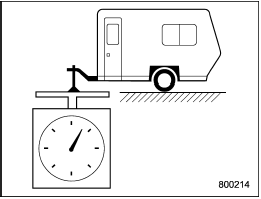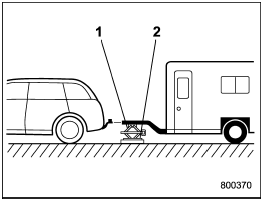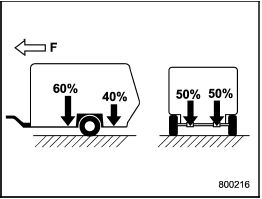 Subaru Forester: Tongue load
Subaru Forester: Tongue load

Tongue load
Ensure that the trailer tongue load is from 8 to 11 percent of the total trailer weight and does not exceed the maximum value of 200 lbs (90 kg).

1) Jack
2) Bathroom scale
The tongue load can be weighed with a bathroom scale as shown in the illustration above. When weighing the tongue load, be sure to position the towing coupler at the height at which it would be during actual towing, using a jack as shown.

F: Front of vehicle
The tongue load can be adjusted by proper distribution of the load in the trailer.
Never load the trailer with more weight in the back than in the front; approximately 60 percent of the trailer load should be in the front and approximately 40 percent in the rear. Also, distribute the load as evenly as possible on both the left and right sides.
Be sure that all cargo is firmly secured to prevent a change in weight distribution while driving.

If the trailer is loaded with more weight in the back of trailer’s axle than in the front, the load is taken off the rear axle of the towing vehicle.
This may cause the rear wheels to skid, especially during braking or when vehicle speed is reduced during cornering, resulting in oversteer, spin out and/or jackknifing.
 Gross Axle Weight (GAW) and Gross Axle Weight Rating
(GAWR)
Gross Axle Weight (GAW) and Gross Axle Weight Rating
(GAWR)
Gross Axle Weight
The total weight applied to each axle
(GAW) must never exceed the Gross Axle
Weight Rating (GAWR). The front and rear
GAWs can be adjusted by relocating
passengers and l ...
 Trailer hitches
Trailer hitches
Never drill the frame or under-body
of your vehicle to install a commercial
trailer hitch. If you do, dangerous
exhaust gas, water or mud may
enter the passenger compartment
through the ...
See also:
Important safety notes
See the "Important safety notes" section ().
If ESP® detects that the vehicle is deviating from the direction desired by the
driver, one or more wheels are braked to stabilize the veh ...
Unlocking the Tailgate
If the power door lock system cannot
unlock the tailgate, unlock it
manually.
Place a cloth on the top side of the
cover to prevent scratches, then use
a small flat-tip screwdriver to rem ...
Warning lights
All-Wheel Drive (AWD) warning
light (AWD models)
The light illuminates when the ignition switch is
turned to the ON position. It turns off after the
engine is started.
If the All-Wheel Drive ...
